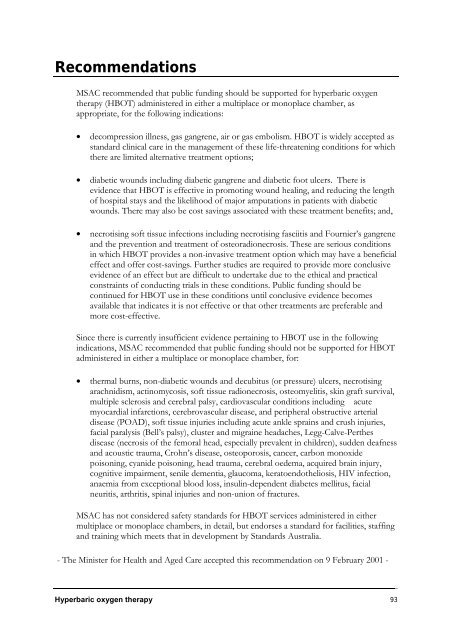Hyperbaric Oxygen Therapy - Hyperbaric Chamber Information ...
Hyperbaric Oxygen Therapy - Hyperbaric Chamber Information ...
Hyperbaric Oxygen Therapy - Hyperbaric Chamber Information ...
Create successful ePaper yourself
Turn your PDF publications into a flip-book with our unique Google optimized e-Paper software.
Recommendations<br />
MSAC recommended that public funding should be supported for hyperbaric oxygen<br />
therapy (HBOT) administered in either a multiplace or monoplace chamber, as<br />
appropriate, for the following indications:<br />
• decompression illness, gas gangrene, air or gas embolism. HBOT is widely accepted as<br />
standard clinical care in the management of these life-threatening conditions for which<br />
there are limited alternative treatment options;<br />
• diabetic wounds including diabetic gangrene and diabetic foot ulcers. There is<br />
evidence that HBOT is effective in promoting wound healing, and reducing the length<br />
of hospital stays and the likelihood of major amputations in patients with diabetic<br />
wounds. There may also be cost savings associated with these treatment benefits; and,<br />
• necrotising soft tissue infections including necrotising fasciitis and Fournier’s gangrene<br />
and the prevention and treatment of osteoradionecrosis. These are serious conditions<br />
in which HBOT provides a non-invasive treatment option which may have a beneficial<br />
effect and offer cost-savings. Further studies are required to provide more conclusive<br />
evidence of an effect but are difficult to undertake due to the ethical and practical<br />
constraints of conducting trials in these conditions. Public funding should be<br />
continued for HBOT use in these conditions until conclusive evidence becomes<br />
available that indicates it is not effective or that other treatments are preferable and<br />
more cost-effective.<br />
Since there is currently insufficient evidence pertaining to HBOT use in the following<br />
indications, MSAC recommended that public funding should not be supported for HBOT<br />
administered in either a multiplace or monoplace chamber, for:<br />
• thermal burns, non-diabetic wounds and decubitus (or pressure) ulcers, necrotising<br />
arachnidism, actinomycosis, soft tissue radionecrosis, osteomyelitis, skin graft survival,<br />
multiple sclerosis and cerebral palsy, cardiovascular conditions including acute<br />
myocardial infarctions, cerebrovascular disease, and peripheral obstructive arterial<br />
disease (POAD), soft tissue injuries including acute ankle sprains and crush injuries,<br />
facial paralysis (Bell’s palsy), cluster and migraine headaches, Legg-Calve-Perthes<br />
disease (necrosis of the femoral head, especially prevalent in children), sudden deafness<br />
and acoustic trauma, Crohn’s disease, osteoporosis, cancer, carbon monoxide<br />
poisoning, cyanide poisoning, head trauma, cerebral oedema, acquired brain injury,<br />
cognitive impairment, senile dementia, glaucoma, keratoendotheliosis, HIV infection,<br />
anaemia from exceptional blood loss, insulin-dependent diabetes mellitus, facial<br />
neuritis, arthritis, spinal injuries and non-union of fractures.<br />
MSAC has not considered safety standards for HBOT services administered in either<br />
multiplace or monoplace chambers, in detail, but endorses a standard for facilities, staffing<br />
and training which meets that in development by Standards Australia.<br />
- The Minister for Health and Aged Care accepted this recommendation on 9 February 2001 -<br />
<strong>Hyperbaric</strong> oxygen therapy 93



